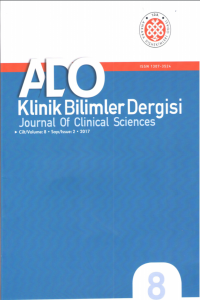Vertikal Kök Kırıkları: Klinik ve Radyografik Bulgular, Risk Faktörleri
Vertikal kök kırıkları, kökün apikal kısmında kök kanal duvarından başlayarak kökün dış yüzeyine ve koronale doğru giden uzunlamasına kırıklar olarak tanımlanmaktadır. Özgün bulgu ve belirtilerin olmaması nedeniyle bu kırıkların kesin teşhisi zor olabilmektedir. Vertikal kök kırıklarının daha çok endodontik tedavi görmüş premolar ve alt 1. molar dişlerde görüldüğü belirlenmiştir. Belirgin olmayan bazı şikayetler, dişeti cebi ve fistül en sık rastlanan klinik bulgular arasındadır. Radyografta klasik periapikal lezyonlara benzemeyen radyolüsensiler izlenebilir, açısal kemik defektleri ve çok köklü dişlerde bifurkasyonda radyolüsensi olabilir. Kırık hattının radyografta görüntülenmesi zordur ve son yıllarda teşhis için konik ışın demetli bilgisayarlı tomografiden yararlanılması önerilmektedir. Endodontik tedavi sırasında kök kanallarının aşırı derecede genişletilmesi, kök kanalının doldurulması sırasında fazla kuvvet uygulanması ve postların kama etkisi kırık oluşumunda önemli risk faktörleri olarak kabul edilmektedir. Vertikal kök kırıkları daha nadir olarak endodontik tedavi görmemiş dişlerde de ortaya çıkabilmektedir. Bu derlemede vertikal kök kırıklarında klinik ve radyografik bulgular ile risk faktörleri gözden geçirilmiştir
Anahtar Kelimeler:
Vertikal kök kırıkları, diş kırıkları, çatlak diş sendromu
Vertical Root Fractures: Clinical and Radiographic Features, Risk Factors
The vertical root fracture is a longitudinally oriented fracture that originates from the root canal wall in the apical part of the root and extends coronally and toward the outer root surface. The diagnosis of this entity is complicated owing to lack of specific signs and symptoms. Vertical root fracture occurs most frequently in endodontically treated premolar and mandibular first molar teeth. Subtle complaints, periodontal pockets and sinus tracts are among the most frequently encountered clinical features. Radiolucencies that do not resemble common periapical lesions, angular bone loss and in multirooted teeth, bifurcation radiolucency can be present. Direct visualization of the fracture line on radiographs may not be possible and currently cone beam computed tomography is suggested for diagnosis. Excessive root canal preparation, excessive condensation force and wedging effects of endodontic posts are considered as significant risk factors. Less frequently, vertical root fractures can occur in nonendodontically treated teeth. Clinical and radiographic features and risk factors of vertical root fractures are discussed in this review article
Keywords:
Vertical root fractures, tooth fractures, cracked tooth syndrome,
___
- Schwarz S., Lohbauer U., Doz P., Petschelt A., Pelka M. Vertical root fractures in crowned te- eth: A report of 32 cases. Quintessence Int. 43: 37–43, 2012.
- Chan C.P., Lin C.P., Tseng S.C., Jeng J.H. Ver- tical root fracture in endodontically versus no- nendodontically treated teeth: a survey of 315 cases in Chinese patients. Oral Surg. Oral Med. Oral Pathol. Oral Radiol. Endod. 87: 504–507, 1999.
- Meister F., Lommel T.J., Gerstein H. Diagnosis and possible causes of vertical root fractures. Oral Surg. 49: 243–253, 1980.
- Cohen S., Blanco L., Berman L. Vertical root frac- tures. Clinical and radiographic diagnosis. J. Am. Dent. Assoc. 134: 434–441, 2003.
- Lustig J.P., Tamse A., Fuss Z. Pattern of bone re- sorption in vertically fractured, endodontically treated teeth. Oral Surg. Oral Med. Oral Pathol. Oral Radiol. Endod. 90: 224–227, 2000.
- Tamse A., Fuss Z., Lustig J., Kaplavi J. An evalua- tion of endodontically treated vertically fractured teeth. J. Endod. 7: 506–508, 1999.
- Testori T., Badino M., Castagnola M. Vertical root fractures in endodontically treated teeth: a clinical survey of 36 cases. J. Endod. 19: 87–91, 1993.
- Cohen S., Berman L.H., Blanco L., Bakland L., Kim J.S. A demographic analysis of vertical root fractures. J. Endod. 32: 1160–1163, 2006.
- Llena-Puy M.C., Forner-Navarro L., Barbero- Navarro I. Vertical root fracture in endodontically treated teeth: a review of 25 cases. Oral Surg. Oral Med. Oral Pathol. Oral Radiol. Endod. 92: 553–555, 2001.
- Tamse A., Kaffe I., Lustig J., Ganor Y., Fuss Z. Radiographic features of vertically fractured en- dodontically treated mesial roots of mandibular molars. Oral Surg. Oral Med. Oral Pathol. Oral Radiol. Endod. 101: 797–802, 2006.
- Ettinger R.L., Qian F. Postprocedural problems in an overdenture population: A longitudinal study. J. Endod. 30: 310–314, 2004.
- Touré B., Faye B., Kane A.W., Lo C.M., Niang B., Boucher Y. Analysis of reasons for extracti- on of endodontically treated teeth: a prospective study. J. Endod. 37: 1512–1515, 2011.
- Fuss Z., Lustig J., Tamse A. Prevalence of vertical root fractures in extracted endodontically treated teeth. Int. Endod. J. 32: 283–286, 1999.
- Zadik Y., Sandler V., Bechor R., Salehrabi R. Analysis of factors related to extraction of endo- dontically treated teeth. Oral Surg. Oral Med. Oral Pathol. Oral Radiol. Endod. 106: e31–5, 2008.
- Morfis A.S. Vertical root fractures. Oral Surg. Oral Med. Oral Pathol. 69: 631–635, 1990.
- 16. Seo D.G., Yi Y.A., Shin S.J., Park J.W. Analysis of factors associated with cracked teeth. J. Endod. 38: 288–292, 2012.
- Fuss Z., Lustig J., Katz A., Tamse A. An evaluation of endodontically treated vertical root fractured teeth: Impact of operative procedures. J. Endod. 27:46–48, 2001.
- Edlund M., Nair M.K., Nair U.P. Detection of ver- tical root fractures by using cone-beam compu- ted tomography: A clinical study. J. Endod. 37: 768–772, 2011.
- Tamse A., Fuss Z., Lustig J., Ganor Y., Kaffe I. Ra- diographic features of vertically fractured, endo- dontically treated maxillary premolars. Oral Surg. Oral Med. Oral Pathol. Oral Radiol. Endod.88: 348–352, 1999.
- ISSN: 1307-3540
- Yayın Aralığı: Yılda 3 Sayı
- Başlangıç: 2006
- Yayıncı: Ankara Diş Hekimleri Odası
Sayıdaki Diğer Makaleler
Pemfigus Vulgaris, Serbest Dişeti Grefti ve İmplant Uygulaması
Emine Elif ALAADDİNOGLU, Bahar Füsun ODUNCUOĞLU
Mandibular Odontomanın Cerrahi Olarak Uzaklaştırılması
Pınar ÇERVATOĞLU ULUS, Hüseyin ASLANTÜRK, Erdal ERDEM
Kronik Böbrek Yetmezliğine Bağlı Renal Osteodistrofide Radyografik Bulgular: Bir Olgu Sunumu
Vertikal Kök Kırıkları: Klinik ve Radyografik Bulgular, Risk Faktörleri
Geniş Periapikal Lezyonlu Dişlerin Cerrahi Olmayan Yöntemle Tedavisi
Mine BOZKURT, Canan DAĞ, Mustafa DAĞ, Nurhan ÖZALP
Dental Travmalarda Ortodontik Yaklaşım
Ezgi KARAÇELEBİ, Mustafa ÖZTÜRK
Submandibular Tükürük Bezi Taşı
